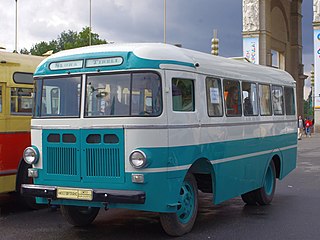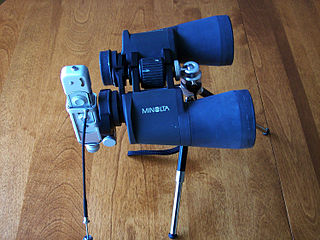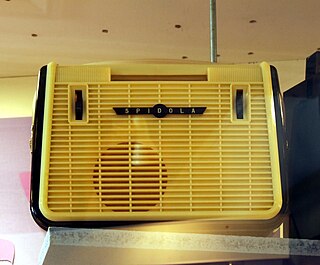
Riga is the capital, the primate, and the largest city of Latvia. Home to 605,273 inhabitants, the city accounts for a third of Latvia's total population. The population of Riga metropolitan area, which stretches beyond the city limits, is estimated at 860,142. The city lies on the Gulf of Riga at the mouth of the Daugava river where it meets the Baltic Sea. Riga's territory covers 307.17 km2 (118.60 sq mi) and lies 1–10 m (3–33 ft) above sea level on a flat and sandy plain.

The Riga Autobus Factory was a factory in Jelgava, Latvia, making vans and minibuses under the brand name Latvija.

Minox is a manufacturer of cameras, known especially for its subminiature camera.

Latvian Air Force is the aviation branch of the National Armed Forces. The first air force (AF) units were established in 1919 and re-established in 1992. It has no air combat capability, thus the defense of Latvian air space is maintained by NATO, with rotating detachments of four aircraft to Lithuania at four-monthly intervals.

House of Prince A/S, is a Danish cigarette manufacturer. As Denmark's only cigarette manufacturer, it was an independent subsidiary of Scandinavian Tobacco Company until its sale to British American Tobacco in 2008.
Latvijas Televīzija is the state-owned public service television broadcaster in Latvia. LTV operates two channels, LTV1 in Latvian and LTV7 in Latvian with selected programming in Russian.
Television in Latvia was first tested in 1937 and introduced in 1954. Latvia was the first country in the Baltic States which started broadcasting.

The Freedom Monument is a monument located in Riga, Latvia, honouring soldiers killed during the Latvian War of Independence (1918–1920). It is considered an important symbol of the freedom, independence, and sovereignty of Latvia. Unveiled in 1935, the 42-metre (138 ft) high monument of granite, travertine, and copper often serves as the focal point of public gatherings and official ceremonies in Riga.

VEF Spidola was the first mass-produced transistor radio with short wave band in the Soviet Union. It was manufactured by the VEF factory in Riga, Latvia, since 1962. A small series under the name "Spidola" had been manufactured since 1960. It was named after the fictional witch Spīdola from the Latvian epic poem.

The National Library of Latvia is a national cultural institution under the supervision of the Ministry of Culture of Latvia. Its current main building is known as the Castle of Light. The National Library of Latvia was formed in 1919 after the independent Republic of Latvia was proclaimed in 1918. The first supervisor of the Library was Jānis Misiņš, a librarian and the founder of the Latvian scientific bibliography (1862–1945). The current building was designed in 1989 by noted Latvian-American architect Gunnar Birkerts (1925–2017), who immigrated to the United States and made his career there. It was constructed in the early 21st century and opened in 2014. Today, the Library plays an important role in the development of Latvia's information society, providing Internet access to residents and supporting research and lifelong education.

The Latvian Basketball League also known as the Pafbet LBL for sponsorship reasons, is the top-level national basketball championship in Latvia composed of 6 teams. Since 2018/19, only the playoff matches are played, as the top Latvian clubs play the regular season in the Latvian–Estonian Basketball League. The LBL is governed by the Latvian Basketball Association, the national governing body of basketball in Latvia.
Bellaccord Electro, generally known as Bellaccord, was the largest record label in Latvia existing in 1931–1950, then renamed.
The Transport Accident and Incident Investigation Bureau is a government agency of Latvia that investigates transport accidents and incidents. It has its head office in Riga. It is functionally independent of the Latvian Civil Aviation Agency. The agency is under the direct supervision of the Minister of Transport and has been so since its creation.

Gulbene is a town in northeastern Latvia. It is an administrative center of Gulbene Municipality.

Māris Čaklais was a Latvian poet, writer, and journalist.

VEF I-17 was a Latvian trainer aircraft designed in 1939 by Latvian aircraft designer Kārlis Irbītis. The I-17 was test flown in early 1940 and almost immediately accepted by Latvian Air Force. It was produced by the VEF factory in Riga.
Aleksandrs Klinklāvs was a Latvian architect.

Gustavs Ērenpreis Bicycle Factory was a manufacturer of bicycles and bicycle parts in Riga, Latvia. The factory was founded in 1927 and continued in private operation until 1942. Prior to World War II it grew to become the largest and most important bicycle factory in Baltic States. After the war, the factory was nationalized by the Soviet Union and became the largest bicycle factory in the Latvian SSR as the Red Star Riga Bicycle Factory.

Brīvības iela is the central street of Riga, the capital and most populous city of Latvia. It is more than 12 km long, cutting across all of Riga, from the historical centre to the outskirts.

The Palace of Justice is a set of courthouses and administrative buildings in Riga. It is the location of sittings of the Supreme Court of Latvia, of the Cabinet of Ministers of Latvia and the headquarters of the Ministry of Justice.



























